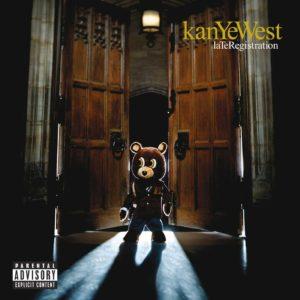Can I talk my shit again?
– “We Major” by Kanye West
Released on this day in 2005, Kanye West dropped his second studio album, Late Registration with Def Jam Recordings and Roc-A-Fella Records. With comparisons to the Beatles’ experimental era, the album led to eight nominations at the 48th Annual Grammy Awards, winning Best Rap Album. In retrospect, the critically acclaimed album showcases why Kanye is still relevant even today, which is his ability to continually reinvent himself, breaking barriers in the process. Whether it’s through a natural conceptual progression and buildup of previous works or veering towards a totally different path to present something ingenious, Kanye is a pioneer and influencer in his own right. His debut album was no doubt a success, but without the constraints of a small budget, Kanye was able to go all in and produced the classic that is Late Registration. He presented a new sound in both songwriting and producing along with the introduction of a relatively new concept for hip-hop albums of the time: self-consciousness. Known for utilizing “chipmunk soul,” he ditched the then-popular sampling style to include live instrumentation, using a 20-piece ensemble.

Effectively still paving new roads as a commercially successful Anti, Kanye succeeded when he intentionally differed from standard Hip Hop conceptually, sonically, and artistically with this album. Kanye’s intention to be relatable to people from all walks of life without sacrificing lyricism while presenting a cinematic journey through storytelling, while spitting on top of production that is expansive in genre and symphonic instrumentation, Late Registration was a great display of what bringing Kanye’s ideas to their fullest form truly means. The Dropout Bear reappears in the sophomore album, serving as continuity for Kanye’s theme of student life and general education, and reinforcing the symbolic nature of the Dropout Bear. In The College Dropout, the mascot symbolized defiance, hope, and uniqueness; he used a teddy bear at the peak of gangsta rap and he chose to drop out of college.
I quickly gravitated towards him sitting alone on the bleachers in the mascot suit. It was interesting to me as The Dropout Bear is meant to be the most popular representation of a school, yet on the cover, it shows Kanye in the mascot suit/head, all alone sitting on bleachers.
– Eric Duvauchelle, Roc-A-Fella’s go-to in-house designer
As for the actual album art, the gold ornaments around the cover was Kanye’s attempt to shatter the archetypal rap artist image, bringing a sense of elegance with the 16th-century illustrations. In Late Registration, the wide-eyed bear is seen swinging through the school doors with his head high, seeking knowledge, while his child-like size relative to the wooden doors symbolizes how rejuvenating the genre would be a big responsibility. The Bear would make one last appearance in Graduation, a triumphant result, and an effective build-up in relation to the last two albums.

An Unlikely Duo Nurtures An Artistic Connection Through Their Exploratory Natures
Kanye scouted film score composer Jon Brion through Brion’s work in The Eternal Sunshine of the Spotless Mind. Kanye also drew inspiration from When the Pawn…, an album by alternative act Fiona Apple, which Brion also produced. They experimented with a variety of sounds, playing with how different instruments and guest features added distinctive textures and effects. Brion has also said that they both see music in an architectural sense, sharing that he sees it as “a spatial thing: left to right, front to back, up and down. It’s animated and it’s moving in real-time.” And that “Kanye has that. He tries things out until it fits until it sits where it is supposed to sit and everything has the correct emotional function.”

Constructing the album through the framework of a film, Kanye visualized the songs as scenes. Although the album spans and critiques multiple issues from institutional racism, consumerism, health care, education, and even the blood diamond trade, the scenes still fit within a structure where there is still a cohesive whole presented. A truly dynamic duo, West’s hip hop production paired with Brion’s orchestration with a shared experimental attitude allowed the piece to have no genre constraints. In addition to social commentary, Kanye’s songs touch on honesty, tongue-in-cheek tales of women who drain men of money, car culture, and more. Like King Midas, Kanye has a natural ability for touching sub-genres into popular sound gold, like what he did on “Drive Slow.” On it, Kanye raps over the popular slowed-down Texas sound, presenting a traditional screwed and chopped beat with his own twist.

